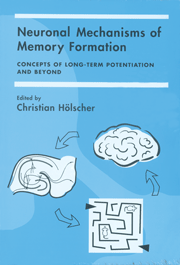Book contents
- Frontmatter
- Contents
- Contributors
- Introduction: Long-Term Potentiation as a Model for Memory Mechanisms: The Story So Far
- Section One Long-Term Potentiation In Vitro and In Vivo: How Can We Fine-Tune the Current Models for Memory Formation?
- 1 Persisting with Long-Term Potentiation as a Memory Mechanism: Clues from Variations in Long-Term Potentiation Maintenance
- 2 Long-Term Potentiation in the Amygdala: Implications for Memory
- 3 Multiple Roles for Synoptic Plasticity in Pavlovian Fear Conditioning
- 4 Plasticity of the Hippocampal Cellular Representation of Space
- Section Two There is More to the Picture Than Long-Term Potentiation: Theta or Gamma Oscillations in the Brain and the Facilitation of Synaptic Plasticity
- Section Three Making Models from Empirical Data of Synaptic Plasticity
- Section Four Setting the Stage for Memory Formation: Stress, Arousal, and Attention
- Section Five Transgenic Mice as Tools to Unravel the Mechanisms of Memory Formation
- Conclusions and Future Targets
- Index
4 - Plasticity of the Hippocampal Cellular Representation of Space
Published online by Cambridge University Press: 13 October 2009
- Frontmatter
- Contents
- Contributors
- Introduction: Long-Term Potentiation as a Model for Memory Mechanisms: The Story So Far
- Section One Long-Term Potentiation In Vitro and In Vivo: How Can We Fine-Tune the Current Models for Memory Formation?
- 1 Persisting with Long-Term Potentiation as a Memory Mechanism: Clues from Variations in Long-Term Potentiation Maintenance
- 2 Long-Term Potentiation in the Amygdala: Implications for Memory
- 3 Multiple Roles for Synoptic Plasticity in Pavlovian Fear Conditioning
- 4 Plasticity of the Hippocampal Cellular Representation of Space
- Section Two There is More to the Picture Than Long-Term Potentiation: Theta or Gamma Oscillations in the Brain and the Facilitation of Synaptic Plasticity
- Section Three Making Models from Empirical Data of Synaptic Plasticity
- Section Four Setting the Stage for Memory Formation: Stress, Arousal, and Attention
- Section Five Transgenic Mice as Tools to Unravel the Mechanisms of Memory Formation
- Conclusions and Future Targets
- Index
Summary
SUMMARY
If the hippocampus is a site for spatial learning, then it should be possible to see changes occurring in its representation of space following learning. How would we recognize such changes? It is argued in this chapter that if the synaptic plasticity hypothesis of learning is true, then to attribute changes in neuronal activity to memory formation, we need (1) to know what the neurons' inputs were before and after learning, and (2) to show that these changed in a meaningful way. By “meaningful” is meant that they altered the cognitive representation in a manner congruent with the actual experience of the animal. Although it is not yet feasible to record single inputs onto hippocampal cells in awake, behaving animals, it is possible to infer the strengths of these inputs by recording the responses of the neurons to environmental stimuli. By showing that the inputs change in an appropriate way following experience, it is possible to derive a simplified model of memory formation that looks at the cognitive representation directly, independent of the animal's behavior. This approach may circumvent some of the difficulties involved in trying to relate very low-level processes, such as synaptic plasticity, with very high-level processes, such as behavior.
Introduction
The hypothesis that a long-term potentiation (LTP)-like process underlies memory formation has the drawback that it is difficult to think of an experimental result that could definitively refute it. For every piece of evidence that appears to falsify the hypothesis, there is either another piece of evidence or a hand-waving argument that explains it away.
- Type
- Chapter
- Information
- Neuronal Mechanisms of Memory FormationConcepts of Long-term Potentiation and Beyond, pp. 100 - 122Publisher: Cambridge University PressPrint publication year: 2000
- 4
- Cited by



